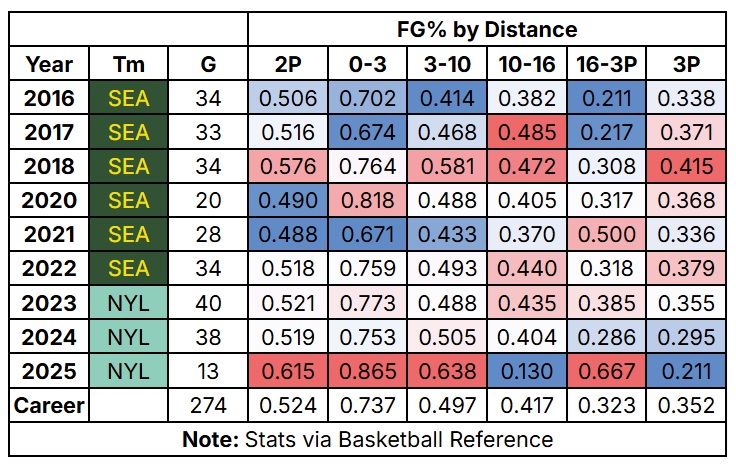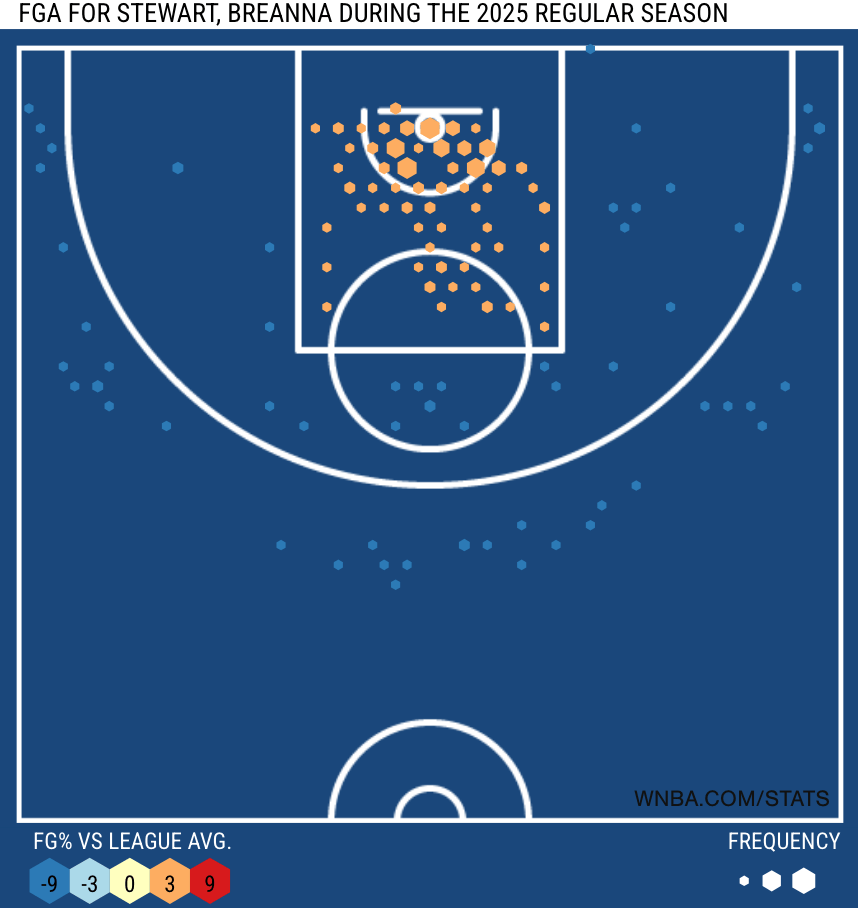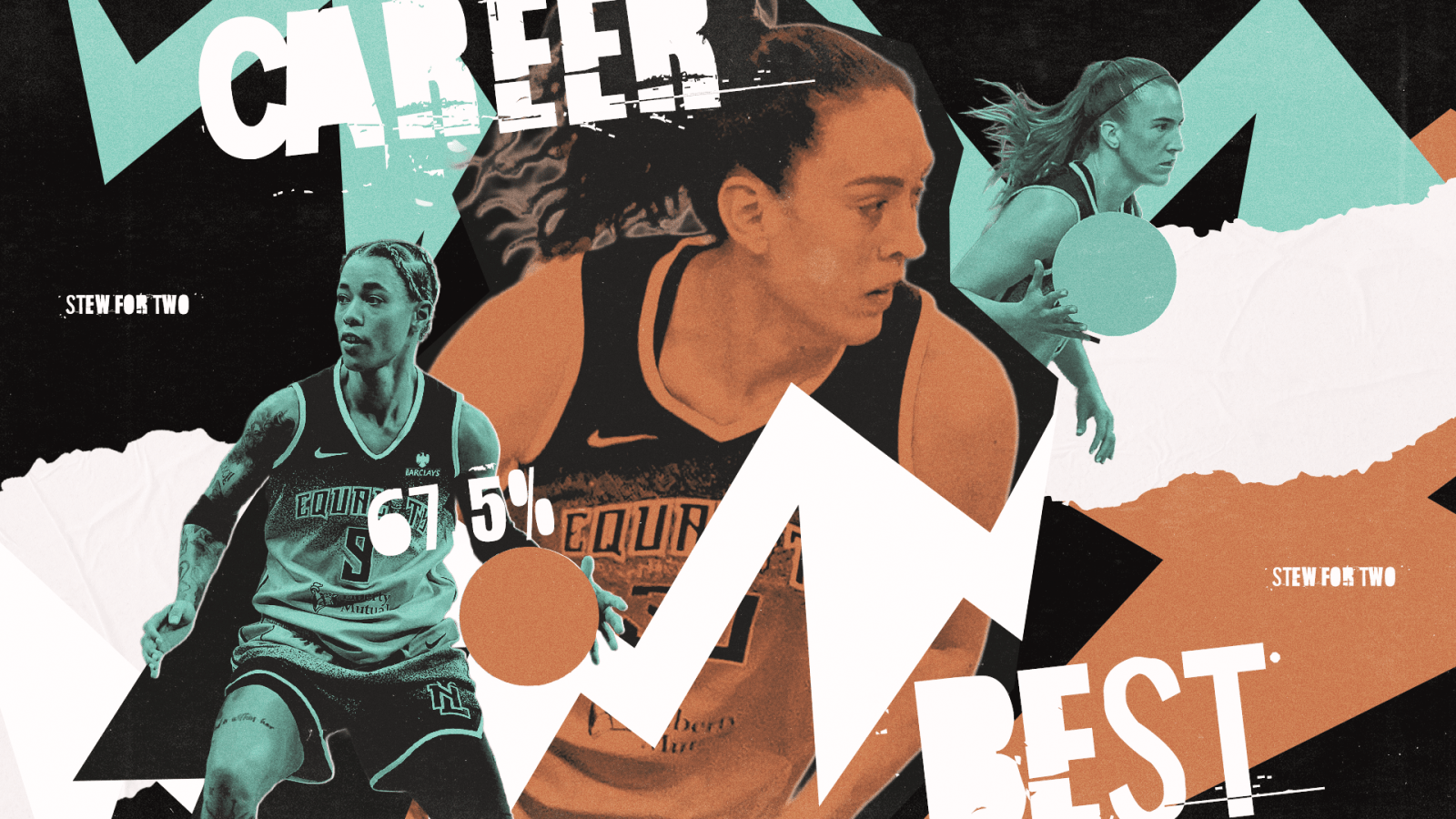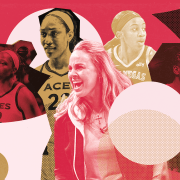As Breanna Stewart dribbles the ball up the court, her Liberty teammates splinter, filling out the perimeter for optimal space. Once Stewart crosses halfcourt, point guard Natasha Cloud flashes to the edge of the Indiana Fever’s circular logo and sets a screen, standing up DeWanna Bonner and forcing guard Kelsey Mitchell into a suboptimal switch. Rather than continuing left, Stewart crosses right back, her gravity earning the attention of both Mitchell and Bonner. She leaves her feet to avoid creating heavy contact and tosses the ball back to Cloud at the top of the key, and by the time it’s caught, she’s already diving to the hoop and calling for it back. Cloud receives and releases in a singular motion, giving Aliyah Boston—the nearest defender at the weak-side hash—no time to provide help. Stewart catches and lays in the easy reverse.
All season long, Stewart has been finding these openings with regularity. The Liberty, like the rest of the basketball world in 2025, have embraced the spacing principles more than ever, allowing any two-player combination on the court to be put into action.
“Our spacing is what we’re focusing on at the moment,” said Brondello, “and then, it’s Stewie making great reads. We talked about how we create more advantages and more space on the perimeter, and we need players that can cut, but she’s cutting to score, and we’re finding her. And she’s finishing at such a high rate.”
Even for a team that is used to playing in space—earlier this season, Nyara Sabally said in jest that they were just shifting from a four-out to a five-out—there were adjustments to be made. But, at its core, this system comes down to timing and trust.
“When it was first implemented, the five-out positionless, it was like, ‘All right, this is kind of extreme in what we’re trying to preach,’” Stewart said of the free-flowing, instinct-led offense. “But we’ve settled in a good happy medium, while also understanding [that]sometimes you don’t want to overcut. Sometimes we want to give space, and realizing whether your person is guarding you or not, the cuts of the basket isn’t always that. Sometimes it’s the cuts to the corner, because then you’re freeing up somebody else. So, we know how important it is to touch the paint, but at the same time, we don’t want to have wasted cuts.”
“We’re just hooping out there,” said Cloud, in her first year running point for the Liberty. “It makes it really easy that we play positionless basketball, where we can be curious and intrigued with our offense and try to figure out how to manipulate defenses on the other side.”
On opening night against the Las Vegas Aces, the Liberty scored 56 points in the paint, tied for this season’s league-high with the Washington Mystics (in a 104-67 blowout over the Connecticut Sun). Twice already, the Liberty have splashed 19 threes, establishing and reestablishing a WNBA regular season record for the most triples in a game.
It’s that balance and veteran continuity from the defending champions that has them atop the WNBA standings in key offensive metrics: points per game (88.3), PACE (calculated as possessions per minute times a 40-minute game) (98.03), and effective field goal percentage (54.3 percent). They’re also just behind the Atlanta Dream for league’s best in offensive rating (108.5 vs 108.3). Stewart, in her ninth WNBA season, is finding success within the scheme’s fluidity.
Through 13 games this season, Stewart is shooting a career-best 61.5 percent inside the arc, per Basketball Reference, far above her career average of 52.4 percent. (For added context, her second-highest mark came in 2018, Stewart’s first MVP season and one of the most efficient in the history of the WNBA; that year, Stewart knocked down 57.6 percent of her two-point looks.)

So much of her scoring has come within the context of the offense, as Stewart has been assisted on 78.4 percent of her makes, the best mark across her three-year Liberty tenure. Per Basketball Reference, her average shot distance is just 11.0 feet from the basket, far below her career average of 12.8 feet and another career-low (and career-best). While Stewart has continued to struggle from three—a worrisome trend dating back to late in the 2023 season—she’s taking fewer threes than ever before. Through 13 games, Stewart is launching just 2.9 threes a night, one full attempt short of her previous career low, and significantly below her career per-game average of 4.6 threes.
Still, even within this early-season small sample, the returns have not been good. Stewart has made just eight of 38 from beyond the arc, steeply below the career 35.3-percent prowess she’s established, and that 21.1 percent hit rate bests only Carla Leite of the Golden State Valkyries (10.7 percent) and Stef Dolson of the Mystics (20.7 percent) among WNBA players with at least 25 attempts. That makes the relative lack of frequency more bearable, until she’s back to knocking them down with more consistency.
A factor contributing to her poor shooting from distance could be injury recovery. Following the Unrivaled season this past winter, Stewart underwent a minor scope on her right meniscus. New York built her up throughout training camp, and it was common to see her stay after practice to get more shots up, with an emphasis on the mechanics, on exploding up.
“It’s gonna take reps,” Stewart said. “It’s gonna take a few games. I’m not consciously feeling, ‘Oh, it’s not falling. I don’t want to take as many.’ Honestly, because it’s not falling, I want to shoot more.”
With the constant movement of the offense: a quick side-to-side swing of the ball, or an initiating dribble-handoff, or—the Liberty’s best offense—a fast break run-out, Stewart often finds herself heading downhill with a step on her defender.
“It’s the flow,” said Stewart. “When we’re running in transition and stuff, at some point I’m breaking that three-point line, or I’m cutting to the basket, or I’m sensing a mismatch. So, I could definitely seek out some more threes, but I’m taking them as I get them, and just going to continue to be confident and aggressive. Because I know I’m a great shooter.”
“She’s such a good player, she’s such an experienced player,” said Sabally. “She knows that if her shots outside might not be falling, she can always get what she needs inside.”
Until those threes begin to fall, though, Stewart is making decisive actions in rotation, attacking closeouts when overloaded defenses are scrambling to recover. With the perimeter spaced and the length of her strides, the help often comes too late to prevent her from getting off a clean look.
The backcourt pairing of Sabrina Ionescu and Cloud has been key to Stewart’s success, with the pair accounting for 55 of her 69 assisted buckets (31 from Cloud, 24 from Ionescu).
With Ionescu, it’s often a timing play: a backdoor cut to a tight window, or an empty-side pick-and-roll, or an outlet pass stretching the boundaries of the 7’1” wingspan that allows Stewart to high-five fans on opposite sides of the tunnel at the same time (!).
See Also
“I kind of view her as the vet that I was able to have,” Ionescu said of the connection she and Stewart have developed since becoming teammates in 2023. “I watch how she’s been able to manipulate defenses, because she’s so versatile. Her ability to read the game and also just understand what teams are giving up, to go in on every single night and take what the defense gives her, but play at her own pace, is really impressive.”
For Cloud, who hasn’t shared the court quite as long, it’s less chemistry-focused, and more a mutual recognition of shared basketball IQ. In the season opener against the Aces, Cloud discerned Las Vegas’ switching scheme, and threw quick entries into Stewart so she could get two feet into the paint before help could close. When the Valkyries whipped out a ton of zone, Cloud force fed the elbow, and Stewart peppered Golden State with midrange jumpers.
“A lot of times, me and Stewie go to ball screens early to see how other teams are going to be playing me and her,” Cloud said. “If they want to switch, then good luck, because I’m just going to pull a b**** out. And If I don’t have Stewie on the post up, we have spray-out kicks for the weak side.”
“It’s just a variety,” Stewart says of the passes from her guards. On one play, it’ll be Ionescu threading the needle with a bounce pass through traffic. On the next, it’ll be Cloud attacking downhill to bait the help before dishing the dime. Or it’ll be Ionescu and Stewart operating the empty-side pick-and-roll, which gives both players tons of space to operate. “They have a great awareness for me, and I definitely appreciate them for that.”
Stewart rewards her teammates’ trust with an uncanny ability to catch passes in traffic and quickly contort through tight windows to get shots up at the rim. “I think it’s impossible not to develop a connection with a player like Stewie. She makes your job a lot easier right on the court with how efficient she plays,” Cloud said. “I’ve been blessed to play with a lot of great players in my career, but Stewie is basically a 6’4” guard, which is just really special to play with.”
 Caption: Breanna Stewart’s hex map of shot frequency and success, via WNBA.com
Caption: Breanna Stewart’s hex map of shot frequency and success, via WNBA.com
Through 13 games, Stewart is shooting 72.1 percent—62 for 86—within eight feet of the rim. That number climbs to 83.3 percent in the restricted area, including a perfect 13-for-13 on cutting layup attempts (all assisted). With all this action around the rim, Stewart’s also getting to the free-throw line at an elite clip, with her 8.2 free throw attempts per game trailing only the 9.6 attempts from the Mystics’ Brittney Sykes. Throughout her career, Stewart has averaged just 5.9 free throws a night, again adding to the efficiency of these drives.
That combination of paint finishing and free-throw frequency has Stewart averaging 20.8 points—third in the W behind Napheesa Collier and A’ja Wilson, and one of just six players at 20+—despite taking just 12.9 shots per game, the fewest in her career. While she’ll mix in a share of rhythm jumpers from midrange, it’s the downhill play that remains a focus for Stewart.
“I’m just attacking what the defense gives me,” she said. “We’ve been working a lot with the touch-and-go ball screens: hitting them quickly and getting out of it where the guard is now on my back.”
She took a beat and smiled, as if gathering herself to rise for an easy two. “And then just getting my head on the rim.”
All stats are current as of June 23, 2025 and, unless otherwise noted, come courtesy of Basketball Reference and WNBA.com.

